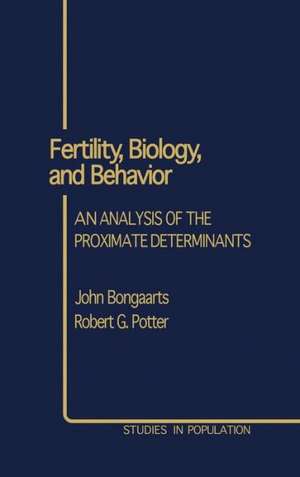Fertility, Biology, and Behavior: An Analysis of the Proximate Determinants: Studies in Population
Autor John Bongaarts, Robert E. Potteren Limba Engleză Hardback – 27 iun 1983
Preț: 434.67 lei
Preț vechi: 564.50 lei
-23% Nou
Puncte Express: 652
Preț estimativ în valută:
83.20€ • 85.74$ • 70.24£
83.20€ • 85.74$ • 70.24£
Carte tipărită la comandă
Livrare economică 01-15 martie
Preluare comenzi: 021 569.72.76
Specificații
ISBN-13: 9780121143800
ISBN-10: 0121143805
Pagini: 230
Dimensiuni: 152 x 229 x 14 mm
Greutate: 0.49 kg
Editura: ELSEVIER SCIENCE
Seria Studies in Population
ISBN-10: 0121143805
Pagini: 230
Dimensiuni: 152 x 229 x 14 mm
Greutate: 0.49 kg
Editura: ELSEVIER SCIENCE
Seria Studies in Population
Cuprins
Preface
Acknowledgments
1 Introduction and Overview
Terminology
The Proximate Determinants
Fertility and the Proximate Determinants
Variations in Individual Fertility
Age-Specific Fertility
The Determinants of the Proximate Variables
The Organization of This Book
References
2 Natural Fertility and Its Proximate Determinants
Natural Fertility
The Proximate Determinants of Natural Marital Fertility
The Effect of the Proximate Determinants on Natural Fertility
Summary
References
3 Regulated Fertility and Its Proximate Determinants
Regulated Fertility
Marriage
Contraceptive Use
Contraceptive Effectiveness
Induced Abortion
Summary
Appendix
References
4 An Aggregate Fertility Model
The Structure of the Model
Direct Estimation of the Fertility Effects of the Proximate Determinants
Testing the Validity of the Model
The Proximate Determinants of Fertility Levels TF, TN, TM, and TFR
Summary
Appendix: An Equation for Estimating Cc
References
5 Applications of an Aggregate Fertility Model
Application 1: The Transition in the Proximate Determinants
Application 2: Decomposition of a Change in Fertility
Application 3: Socioeconomic Differentials in Marital Fertility
Application 4: An Age-Specific Fertility Model
Application 5: The Empirical Relationship between Fertility and Contraceptive Prevalence
Application 6: Projected Fertility Trends Associated with Changes in Contraceptive Practice
Application 7: Contraceptive Prevalence Levels Required to Reach a Fertility Target
Summary
References
6 A Macrosimulation Model and Applications to Fecundity and Natural Fertility
Introduction
Reproductive Models
REPMOD
Validation of the Model
Application to Fecundity
Natural Fertility
Summary
References
7 Family-Size Control
Introduction
Operationalization
Subfertility
Excess Fertility
Some Additional Topics
Summary
References
8 Birth Spacing
Introduction
Previous Study
Unregulated Birth Spacing
Master-Schedule Spacing
Serial-Spacing Preferences
Evaluating Fecundability
Pinpoint Spacing
Summary
References
9 Sex Preselection
Introduction
Previous Research
An Alternative Approach
Assumptions
Birth-Trial Probabilities
Family Composition without Sex Preselection
Sequential Goals
Compositional Goals
Spacing Consequences
Summary
References
Subject Index











